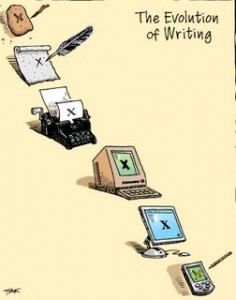In Chapter 3: Some Psychodynamics of Orality in the book Orality and Literacy, Walter Ong examines primary oral cultures: People who have no system of writing. For oral cultures, words are only represented as sounds. Ong says that the problem with sound is that it is evanescent: It can’t be stopped and preserved. When it is stopped, there is nothing only silence. (Ong, p.32) He explores how oral cultures can recall words if they are unable to record them through writing considering the fact that literate cultures procure their information from written information: “The organized knowledge that literates today study so that they know it, that is, can recall it, has, with very few if any exceptions, been assembled and made available to them in writing.” (Ong, p.33) He suggests that it is through the use of mnemonics and formulas that oral cultures can recall information. Mnemonics and formulas provide a basis for thinking for oral cultures due to their rhythmic sounds that are easy to retain and recall. (Ong, p.34-35) Ong also credits additional characteristics with helping oral cultures think, express themselves, and memorize information. These characteristic of thought and expression are as follows:
· Additive rather than subordinative: Oral cultures use less structure than written cultures and are not as concerned with the rules of grammar as much as literate cultures. They express themselves by appending their thoughts together in a pragmatic manner. (Ong, p.37)
· Aggregative rather than analytic: Oral cultures use formulaic oral expressions to make expressions more meaningful and memorable. (Ong, p.38)
· Redundant or copious: Oral cultures repeat information so that it becomes ingrained in memory. (Ong, p.39)
· Conservative or traditionalist: Oral cultures repeat information over and over again to ingrain the information and avoid adding any extra information as it would be too much of a burden to remember. (Ong, p.41)
· Close to the human lifeworld: Oral cultures remember information that is familiar to their surroundings and their own life experiences. (Ong, p.42)
· Agonistically toned: Oral cultures remember dramatic events that have a tone that expresses drama and agony. (Ong, p.43)
· Empathetic and participatory rather than objectively distanced: Oral cultures prefer being close to their audience where the audience and the speaker each have influence over each other. (Ong, p.45)
· Homeostatic: Oral cultures retain information that pertains to their current situation, not dwelling on the past. (Ong, p.46)
· Situational rather than abstract: Oral cultures learn about ideas and concepts that actually exist. (Ong, p.49)
Ong believes that oral cultures are not able to process complex topics such as geometry, categorization, logical reasoning and definitions for example because he believes that cultures need to be literate in order to engage in these types of thought processes that are generated through reading and writing text. (Ong, p.55) In addition, Ong suggests that oral and literate cultures process information differently which is referred to as the Great Divide Theory. However, Chandler (1994) states that “those in non-literate societies do not necessarily think in fundamentally different ways from those in literate societies, as is commonly assumed. Differences of behaviour and modes of expression clearly exist, but psychological differences are often exaggerated.” (Chandler, 1994)
Regardless of whether a culture is oral or literate, both cultures are able to learn and the ways in which they learn are similar based on identical learning theories. Ong’s characteristics of thought and expression pertain to the cognitivism and constructivism learning theories.
Mnemonics, which Ong described as helping oral cultures recall information have also been described by Driscoll (2002) as helping the encoding of information by making new material more memorable to learn. (Driscoll, p. 92) When oral cultures repeat information in order to learn it, this is referred to as rehearsal which is an effective means for learning information that is non-complex in nature. (Driscoll, p.91) Both mnemonics and rehearsal are categorised as being part of the cognitivism learning theory. (Driscoll, 2000)
Ong describes thought and expression as additive for oral cultures whereby thoughts are informally appended together as opposed to subordinative whereby phrases are more formally joined together for literate cultures. Clark and Mayer (2008) state that a less formal conversational style from either spoken or written text is an effective way to engage people in deeper cognitive processing because people will try harder to understand what the person is saying. (Clark & Mayer p.163)
When oral cultures remember thoughts and expression that are close to the human lifeworld, homeostatic, and situational, these all touch on the constructivism learning theory whereby people learn by constructing new knowledge based on the knowledge that they have already acquired. (Driscoll, p. 375)
When Ong states that thoughts and expression are empathetic and participatory for oral cultures, research has proven that people learn more from a collaborative learning environment than from learning alone. (Clark & Mayer p.278) In addition, Postman (2002) states that orality places emphasis on collaborative learning. (Postman, p.17)
Although people have depended more on print for their learning during the past four centuries, people can still learn by using the means that oral cultures did in the past. Ong’s characteristics of thought and expression conform to the cognitivism and constructivism learning theories that describe some of the ways that both oral and literate cultures learn.
References
Chandler, D. (1994). Biases of the ear and eye: “Great Divide” Theories, Phonocentrism, Graphocentrism & Logocentrism [Online]. Retrieved 28 September, 2009 from:
http://www.aber.ac.uk/media/Documents/litoral/litoral.html
Clark, R. C., & Mayer, R. E. (2008). e-Learning and the Science of Instruction: Pfeiffer San Francisco.
Driscoll, M.P. (2000). Psychology of Learning for Instruction. Boston: Allyn and Bacon.
Ong, Walter (1982). Orality and literacy: The Technologizing of the Word. London: Methuen.
Postman, N. (1992). Technopoly: The Surrender of Culture to Technology. New York: Vintage Books.

